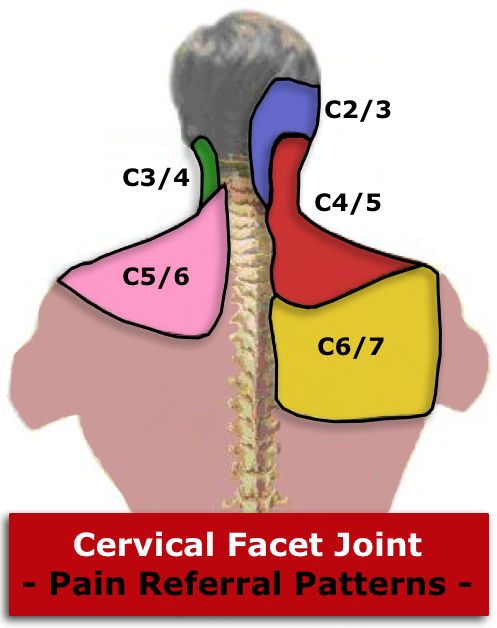Both neck and shoulder pain are common musculoskeletal complaints that account for many physician visits yearly. The primary drivers of shoulder symptoms are diverse and can include the rotator cuff complex, the glenohumeral joint, the acromioclavicular joint, the sternoclavicular joint and other soft and inert tissue structures around the shoulder.

Cervical Facet Joint
However, the neck itself can also create an amount of shoulder pain/symptoms. In the cervical spine, the movement is achieved from the zygapophyseal and uncovertebral joints, which are synovial joints between two vertebrae. In conjunction with the disc, the facet joints to aid in the distribution of force/load and guide spinal motion via their interconnections and the shapes of their anatomical surfaces.
When these joint capsules get irritated or inflamed, they can refer pain into other areas of the body.
This irritation can be due to underlying hypermobility, facet joint arthritis, degenerative osteophytes or uncovertebral spurring, joint capsule stiffness, shortening or scarring from prolonged motion segment hypomobilities and protective muscular spasm.
Cervical segments
The upper cervical segments C0-4 will often refer pain to the temporal and occipital regions of the head. The lower cervical spinal segments C4-7 will refer pain distally to the upper, mid and lower periscapular regions, often mimicking shoulder pain.
A very thorough clinical examination will include testing of both the cervical spine and shoulder complex, ensuring to include neurology, passive physiological and accessory intervertebral motion, and directional articular stability. This approach will aid the differential diagnosis.
Treatments for Neck and Shoulder Pain
Your clinician will provide a multimodal interventional approach, including manual mobilization techniques, as well as strengthening, endurance, flexibility, postural work, coordination and aerobic/functional exercises.
In chronic neck derived shoulder pain, clinicians often also provide patient education and advice focusing on assurance, encouragement, prognosis and pain management. Mobilization combined with an individualized, progressive, submaximal exercise program has been found to be of benefit.
This will include cervicothoracic and scapulothoracic strengthening exercises. In certain cases, electrophysical modalities such as IFC and TENS may be used to aid in symptom management and allow better participation in the active rehabilitation program.
In chronic cases, should there be no contraindications and consent be discussed and received, cervicothoracic manipulation or mobilizations combined with shoulder girdle and neck stretching, strengthening and endurance has proven to be a beneficial intervention? Intermittent cervical traction combined with the above-mentioned interventions may also be utilized.
In chronic cases that are unresponsive to treatment, a referral to interventional radiology may be recommended for consideration of candidacy for interventional facet injections for both diagnostic and therapeutic purposes. This alone may allow the client to better participate in an active rehabilitation program but is often followed up with comparative medial branch blocks for consideration for radiofrequency ablation therapies.
1. JOSPT. Clinical Practice Guidelines. Neck Pain (2017).





